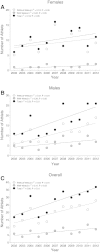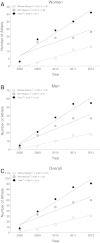Swimming performances in long distance open-water events with and without wetsuit
- PMID: 24891942
- PMCID: PMC4041346
- DOI: 10.1186/2052-1847-6-20
Swimming performances in long distance open-water events with and without wetsuit
Abstract
Background: Existing literature showed improved swimming performances for swimmers wearing wetsuits competing under standardized conditions in races held in pools on short to middle distances. Data about the influence of wetsuits on swimming performances in long and ultra-long open-water swimming races are missing. It is unknown whether the benefit of wearing wetsuits is comparable in men and women. The aim of this study was to investigate the influence of wearing a wetsuit on open-water swimming performances at the 26.4 km 'Marathon Swim in Lake Zurich' in Lake Zurich, Switzerland, and the 3.8 km Lake Ontario Swim Team-Race (LOST-Race) in Lake Ontario, Canada.
Methods: Race times of the fastest female and male swimmers competing with and without wetsuit were compared using multi-level regression analyses and analysis of variance.
Results: In the 'Marathon Swim' in Lake Zurich, wearing a wetsuit had no effect on race time regarding the gender where athletes wearing a wetsuit were not faster than athletes without wetsuit. However, the ten fastest men wearing a wetsuit (410.6 ± 26.7 min) were faster (32.7%, p < 0.01) than the ten fastest women without wetsuit (544.9 ± 81.3 min). In the 'LOST-Race', the top ten men wearing a wetsuit (51.7 ± 2.5 min) were faster (13.2%, p < 0.01) than the top ten women wearing a wetsuit (58.5 ± 3.2 min). Additionally, the top ten men without wetsuit (52.1 ± 2.4 min) were faster (19.6%, p < 0.01) than the top ten women without wetsuit (62.3 ± 2.5 min). The top ten women wearing a wetsuit (58.5 ± 3.2 min) were faster (6.5%, p < 0.01) than top ten women without a wetsuit (62.3 ± 25 min).
Conclusions: These results suggest that wearing a wetsuit had a positive influence on swimming speed for both women and men but the benefit of the use of wetsuits seemed to depend on additional factors (i.e. race distance). Women seemed to benefit more from wearing wetsuits than men in longer open-water ultra-distance swimming races.
Keywords: Ironman; Neoprene suit; Swim performance; Swimming; Ultra-endurance.
Figures








Similar articles
-
The relationship of wearing a wetsuit in long-distance open-water swimming with sex, age, calendar year, performance, and nationality - crossing the "Strait of Gibraltar".Open Access J Sports Med. 2018 Feb 21;9:27-36. doi: 10.2147/OAJSM.S158502. eCollection 2018. Open Access J Sports Med. 2018. PMID: 29503588 Free PMC article.
-
Sex Differences in Swimming Disciplines-Can Women Outperform Men in Swimming?Int J Environ Res Public Health. 2020 May 22;17(10):3651. doi: 10.3390/ijerph17103651. Int J Environ Res Public Health. 2020. PMID: 32456109 Free PMC article. Review.
-
Effect of Wetsuit Use on Body Temperature and Swimming Performance During Training in the Pool: Recommendations for Open-Water Swimming Training With Wetsuits.Int J Sports Physiol Perform. 2024 Jan 8;19(4):407-411. doi: 10.1123/ijspp.2022-0222. Print 2024 Apr 1. Int J Sports Physiol Perform. 2024. PMID: 38194956
-
Wetsuits, body density and swimming performance.Br J Sports Med. 1991 Mar;25(1):31-3. doi: 10.1136/bjsm.25.1.31. Br J Sports Med. 1991. PMID: 1913028 Free PMC article.
-
Wetsuit Use During Open Water Swimming. Does It "Suit" Everybody? A Narrative Review.Int J Sports Physiol Perform. 2021 Sep 1;16(9):1217-1224. doi: 10.1123/ijspp.2020-0808. Epub 2021 Jul 26. Int J Sports Physiol Perform. 2021. PMID: 34311439 Review.
Cited by
-
What predicts performance in ultra-triathlon races? - a comparison between Ironman distance triathlon and ultra-triathlon.Open Access J Sports Med. 2015 May 18;6:149-59. doi: 10.2147/OAJSM.S79273. eCollection 2015. Open Access J Sports Med. 2015. PMID: 26056498 Free PMC article. Review.
-
The relationship of wearing a wetsuit in long-distance open-water swimming with sex, age, calendar year, performance, and nationality - crossing the "Strait of Gibraltar".Open Access J Sports Med. 2018 Feb 21;9:27-36. doi: 10.2147/OAJSM.S158502. eCollection 2018. Open Access J Sports Med. 2018. PMID: 29503588 Free PMC article.
-
Shoulder Muscle Activity While Swimming in Different Wetsuits and Across Different Paces.Int J Exerc Sci. 2023 Feb 1;16(1):172-181. doi: 10.70252/PXWH5897. eCollection 2023. Int J Exerc Sci. 2023. PMID: 37113261 Free PMC article.
-
Sex Differences in Swimming Disciplines-Can Women Outperform Men in Swimming?Int J Environ Res Public Health. 2020 May 22;17(10):3651. doi: 10.3390/ijerph17103651. Int J Environ Res Public Health. 2020. PMID: 32456109 Free PMC article. Review.
-
Case Report: Differences in self-selected pacing in 20, 40, and 60 ironman-distance triathlons: a case study.Front Sports Act Living. 2024 Sep 16;6:1155844. doi: 10.3389/fspor.2024.1155844. eCollection 2024. Front Sports Act Living. 2024. PMID: 39351144 Free PMC article.
References
-
- Knechtle B, Knechtle P, Rosemann T. Low prevalence of exercise-associated hyponatremia in male 100 km ultra-marathon runners in Switzerland. Eur J Appl Physiol. 2011;111:1007–1016. - PubMed
LinkOut - more resources
Full Text Sources
Other Literature Sources

